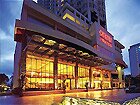The Taoist Worship Rituals practiced during the Nine Emperor Gods Festival is generally the same kind performed during the ordinary occasions.
Basically there are two types of Worship Rituals. One is Idol Worship and the other is invisible spirits worship.
The Idol worship uses statues of great gods and deities while invisible spirit worship uses spirit mediums who goes into a trance like state. Both are inseparable, to say the least.
Read about the page here:
- Two Basic Worship Rituals
- Ways to offer prayers
- The 8th night and birthday of Duo Mo
- Idol Worship
- Spirit Medium Worship
- Fort Crossing Ceremony
- The Sending-Off Ceremony
- The Economics
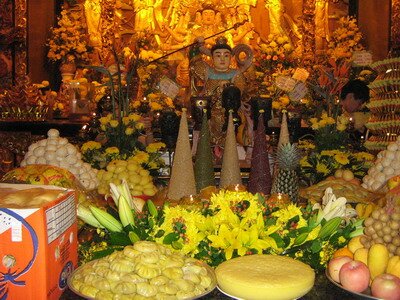
The Taoist Worship Ritual in the festival requires the devotee to be at the temple to offer prayers. The needs to pray to Taoist Gods and other deities is done with the intention of communicating the prayers.
So the Taoist Worship rituals to offer prayers can be seen through greeting gestures and prostration in front of the altar of the Nine Emperor Gods.
One can offer the prayers silently or audibly. Reciting sacred scriptures or holy incantation on your knees or sitting in a lotus like position is seen on non peaked season.
I observed some making vows and returning vows in this Taoist Worship rituals. In the case of trouble or problems, spiritual help is needed, one will seek the spirit medium.
Some temples have assigned time table when these help can be arranged. For the locals, it is simply called "Pai Ang Kong" or Mui Ang Kong.
My euphoric state of mind was expressed in my article on the Raja Uda Butterworth Tow Boo Kong Taoist Temple as they prepared for the Nine Emperor Gods celebrations.
It is going to be THE FESTIVALS of the Year. Don't believe me, follow the many pages I wrote about the elaborate event in Butterworth Penang. I do find the Taoist Worship Ritual very enlightening.
Being in Raja Uda Nine Emperor Gods Temple for the festival has proved to be worthwhile.
The devotees sensing my quest to understand the Taoist Worship Rituals has been so helpful. With a warm and sincere smile, they shared their version of Taoist Worship Rituals.
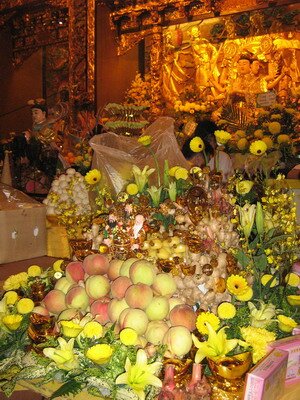
Since it is Dou Mu birthday, I prayed and offer my heartfelt prayer following the Taoist Worship Rituals.
This Heaven Honored Big Dipper Mother is said to have gained Enlightenment after years of meditation.
She gave her Nine sons the knowledge and so impressed was Heavenly Gods that they were placed in control of the north pole. And stars of the Big Dipper revolved under the surveillance of the nine sons.
Together they were endowed with the power of controlling the heavens and the existence of all earthly creatures below. Dou Mu is conceived of as the Goddess of Loving Kindness and Mercy.
She helps Heaven maintain the universe in equilibrium. She provides for human sustenance, judges human deeds and misdeeds.
She controls life and death and bestows upon humans rank and status, luck and fortune, prosperity and happiness, health and long life.
This welcoming ceremony of the Star Deities or The Big Dipper is unexplainable. The ceremony is performed in total secrecy as all devotees stayed bowed.
I hope to be forgiven as I stood through to snap some awesome pictures. It was a moment of greatness and reverence.
Dou Mu nine pairs of arms, which represent the Nine Emperor Gods, extend in every direction of the compass to meet human needs and to offer solace and comfort during times of suffering.
The three faces of Dou Mu express the "triple gems" of fortune, prosperity, and long life.
Despite Duo Mu's importance, however, the overall power lies squarely in the hands of the Nine Emperor Gods, the inheritors and promoters of Dou Mu's virtues and powers.
The big Dipper Mother has nine eyes (three on each of her three faces) representing the all-seeing stars and the all-knowing star deities, and her nine pairs of arms hold nine precious objects that symbolize nine special qualities.
Basically, the Raja Uda temple devotees shared with me their style of performing the Taoist worship rituals.
Some would offer fruits, flowers or tea. But most agreed, the foremost thing to do in Taoist worship Rituals, offer prayers using joss stick before doing any other rituals.
So off I purchased a set of joss stick and in it I found a pair of candle and joss paper. They guided me to offer my prayer to the God's altar.
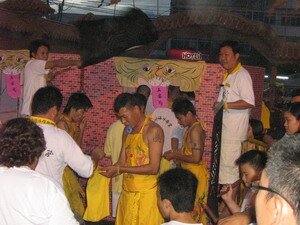
First I lighted the candles on both sides of the candles stand. Then I find a suitable place to keep my joss paper for burning.
Having done that, I proceeded outside the temple and offer prayers to the God of Heaven. Then prayers to the first hall where Duo Mu presides over the Nine Emperor Gods and his deputies, like the monkey god, Na Zha and all their General are seated.
Makes me recall Lady Precious Stream. If you remember, generals of the northern and southern front.
Read more about the roles of Spirit Mediums as I share more on this absolutely spectacular event held on the third day of Butterworth Nine Emperor Gods Festival held in Tow Boo Kong Taoist Temple.
I walked to the second level and third level where Dou Mu is majestically placed. I was advised to place three joss stick per urn after praying. It was good fun to learn the Taoist Worship Rituals so far.
Not forgetting what I did when I placed the joss stick, firstly raise the joss stick a little higher than my head and close your eyes and pray.
After praying, shake and worship the joss stick three times, kneel three times and bow your head till it touches the floor three times. Three times means once per level makes nine times in this Taoist worship Rituals.
Also remember to pray with both palms pressed together, kneeling with both feet side by side, no gaps opening between the thighs and with forehead touching the floor for the Taoist worship rituals.
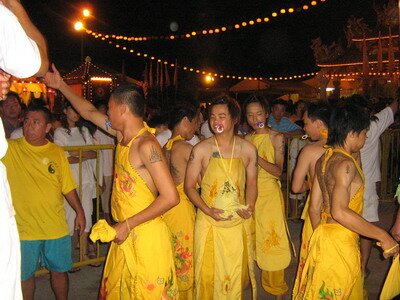
In this manner, you are offering your prayers to the nine kings, nine emperors and nine dynasties monarchs.
These gestures of nine actions with you moving your upper, middle and lower part of your body signifies prayers concentration to Heaven, Earth and Hell can be found in most religion and explained well in Taoist Worship Rituals.
The Taoist Purification Rituals can be daunting and unreal but permit me to share some insiders knowledge.
The Chinese cultures bought to us by our forefathers are very much intact in us, Malaysian and locals of Penang and Butterworth. Most cultures are actively participated and alive in this part of the world.
We feel blessed by the Gods we worshiped. This is a great symbolic awakening for me to be in formation with the spirit, mind and body. How wonderfully grateful I felt after this prayer.
I felt really good and went to perform the sacrificial burning of the joss paper. As I saw many devotees "adding oil to the temple lamps", (tiam teng or tnee ewe) I then inquire the reasons for doing so.
Some oil can be offered, added or make offering for the sake of oneself or others. In performing this, it will ascertain the God's response to prayers, vows, offerings or sacrifices.
It is the highest act of divinity for humans. In other Taoist temple, like Goddess of Mercy in Penang, there is even a god of Time statue where the practices of sustaining one's life is carried out.
They further inquired whether I am in need of spiritual help to which I kindly turned down. I understand what happen when one invoke spirit mediums for help. It brought back memories of what dad used to do when I got sick.
Dad would used the spirit mediums's help for anything from advises about life, future, education, health and etc. He would go ritually every week to a temple and seek this spiritual help.
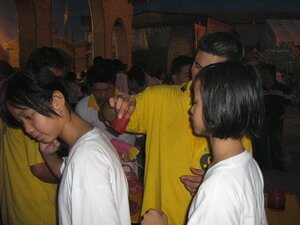
The spirit medium "tangki" or depending on the temple, you called the spirit mediums or the trance like deity with their names, Tai Chu or whatever.
In these Taoist Worship Rituals, the spirit medium will draw or write on yellow paper, some "god words" in red calligraphy mandarin called talisman or amulet or plain Chinese "Hoo".
This little yellowish paper with calligraphic inscriptions can be kept in red packet or burned and drunk. Well, does it worked? It must have as we were poor and had no money to seek modern medicine then.
9th day of Nine Emperor Gods Festivals
If you are more into inner peace, tranquility and serenity, one temple in Penang celebrating the Nine Emperor Gods festival is the Cheng Kon Sze Taoist Temple. This temple is unexplored, old and real.
Looking for a place to meditate, this is THE temple! Find out more from here. Taoist Worship Rituals are subtly practiced in this 110 years old temple.
The Fort passing or crossing ceremony was held on the last evening of the Nine Emperor Gods festivals. We entered the compound of the Butterworth Temple amidst the gongs and cymbals sounding away so excitedly.
Preparation for the Fort crossing has started. This is the last cleansing procession of the festivals and the last day to collect cash or donations.
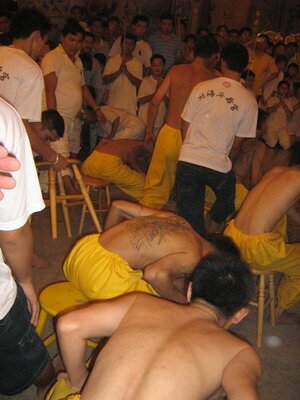
So the process of the Tai Chu getting into the trance like dance ritual commences this ceremony. I hear them happily calling for all to participate in this ceremony. I tried to understand what was going on.
Two forts were built side by side. It is made with some thin bamboo like stem and pasted with colorful papers. Two paths were created as passages for the devotee to cross. Inside the fort, stood a small fire pit.
A senior devotee having seen me for many days there, explain the rituals. The fort crossing or passing represents the surmounting of yin and activating the yang energy.
These Taoist Worship Rituals is interrelated in meaning as that of the fire walking. The ceremony is open to everyone regardless of age and sex.
As the devotees proceed to the fort, a Taoist priest stamps a red seal on the back of their shirt or blouse, the insignia of the emperors stamped across their shoulders, a divine promise to shield them against evil.
But otherwise described as 'luck' by the woman who encouraged me to have the permanent crimson ink branded on my blouse.
The devotees crossed the fort in single file, many of them carrying bundles of clothes and personal belongings. The clothes of their loved ones were seen carried across by the head of the family.
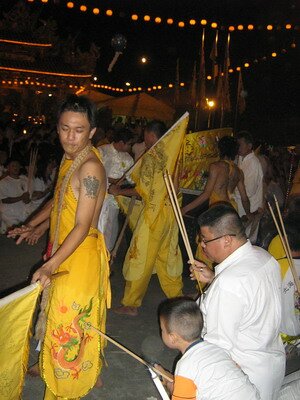
It will then be marked with the seal of the Nine Emperor Gods to confer luck to whoever wears them. As they are about to cross the fort, the devotees deposited cash (or ang pows containing cash) into a yellow sack.
The Tai Chu cheerfully accepted and in turn blessed the devotee. The devotee believed that the offering they did will bring good luck and abundant blessings from heaven.
People believe that crossing the fort without incident is a clear sign that their good fortune and their standing with the star deities are assured.
Tai Chu with their whips performed the trance like dance rituals and repeatedly cross the fort as if chasing the evil spirits. Some even walked across with the old and aged and the kids on their back.
By crossing the fort, the devotees negate evil and acquire spiritual confidence and power, not only over themselves but also over the environment in which they live.
By walking over the fire, by virtue of their ritual purity, enact the victory of good over bad, mind over matter.
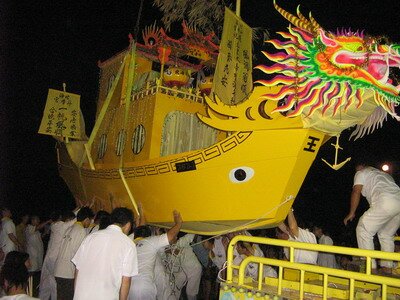
Having completed the Fort Crossing Ceremony, the crowd is getting thicker by the minutes as it was time for the send off street procession.
The temple ground are packed with people standing, sitting with hands clasped with joss sticks. The street procession floats are lighted, all waiting for the Big Dipper star deities return to the sea.
The Sending Off ceremony ends the Taoist Worship Rituals, notably with the Ong Chun. The effigy of the Emperor Boat was loaded with food incense, joss paper piles together with other ritual items.
I stayed within feet of the mediums as they gathered beside their respective stools while a primeval pounding on large drums, gongs summoned their possessors. They yawned or made retching noises, the first signs of trance.
Their heads began to shimmy sideways faster and faster, their eyes rolled and finally, they yelled to herald the god's arrival and rushed to the altar upon which his image stood.
The mediums donned their gods' clothing of aprons and loose pants, unfurled their flags and rid the air of harmful spirits with sharp cracks of long whips.
After their trials by fire, blade or sword, the mediums returned to the altar and fell back into the arms of assistants, one of whom straightened their rigid limbs and gently pressed between their eyebrows to seal the invisible third eye through which the spirit medium receives his superior insight.
They spoke in high-pitched voices and used an old Chinese dialect which their assistants translated. Then waved the Trigam flag and got everyone head bowed.
Once the Presiding Trustee was ceremoniously in her float, the street procession moves on with devotees closely following both in front and behind.
The procession take the same route it came and the 5km routes will once again marched on for 2 hours before it reaches Pantai Bersih, some 10 minutes away by car.
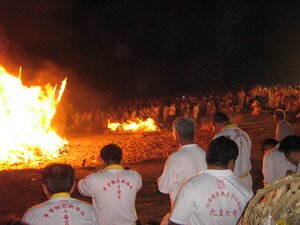
When the procession of Tai Chus, Nine Emperor Gods Deputies or Spirits Mediums wound through streets, amid the sounding of gongs and cymbals, silent residents with heads dipped and hands together in reverent gratitude lined the sidewalks to watch them pass.
We had the opportunity to watched three temples performing the "sending off ceremony" and burn the Nine emperor Gods boat. But none as spectacular as the Tow Boo Kong Ong Chun.
Waiting for the procession to arrive, a crane was hired to help lift the Butterworth Tow Boo Kong "Ong Chun" out of the float it was paraded.
The Presiding Lor Chu, for the last time did the handling over of the Urn to the temple senior to release the Star Dipper off the Urn. She prayed and bowed like all of us in Taoist Worship Rituals.
As we watched the boat being send off, funnily all present for that hour could feel a certain kind of lost.
Some temple senior was heard saying this, "The deities who attend the festival are dispatched to their proper places. The territorial spirit soldiers who gathered at the five ritual camps during the festival begin to disperse and return to their respective posts."
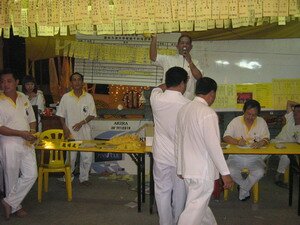
Thus the pomp and grandeur of the street processions, the din of the 'spirit mediums' trance dances and exorcising rituals, and the religious fervor and joy of the worshippers and spectators all come to an end. The tall lamp is then lowered at noon on the tenth day.
After the ceremonies for sending off the Nine Emperor Gods and lowering the tall-lamp the Festival of the Nine Emperor Gods is brought to an end. But for Girlie, her role to help the new Presiding Trustee has began.
The Nine Emperor Gods Festival is the major festival centered in the Taoist Temple. The temple is quiet through out the year. Two economic aspect are equally important for the temple to function.
Firstly, the internal activity in the form of festivities, religious services from the devotees to sustain the temple smooth functioning.
It open its arms to new comers, also expanded as a place for meditation, study of scriptures and kept the community intact and close knitted.
Secondly, it provides good business of hawkers, vegetable sellers, local business of Taoist Worship Rituals items. Devotees are required to pay varying sums of money for ceremonies to maintain luck, to dissolve ill luck, and to give thanks.
Hence the Festival of the Nine Emperor Gods maybe seen not only as a spiritually inspired religious celebration, but also as an economically motivated religious fair.
While I acknowledge the references I based my research, most are my personal experiences during the recent Nine Emperors Festival in 3 local Taoist Temples.
My heartfelt gratitude to Girlie Chuah (the Presiding Lor Chu), Mr Khor Temple Chairman and devotees of Tow Boo Kong, Kepala Batas and Cheng Kon Sze who shared their many tales and experiences.
Without them, I would not have completed this extensive article on Taoist Worship Rituals.
References and Acknowledgement with thanks
CHEU HOCK TONG
National University of Singapore, The Festival of the Nine Emperor Gods in Malaysia
The Encyclopedia, People and Traditions Vol.
Editor Prof Dato' Dr Hood Salleh
Go to Top of Taoist Worship Rituals Page
Back to Taoist Purification Rituals Page
Back to My Island Penang Home Page




















